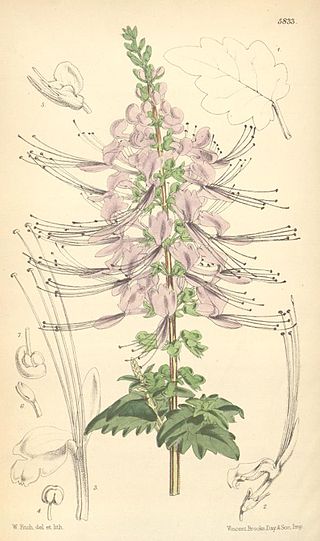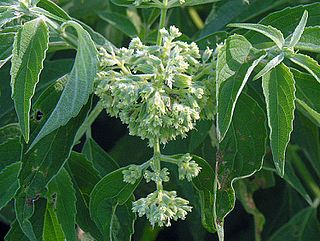
The Lamiaceae or Labiatae are a family of flowering plants commonly known as the mint, deadnettle or sage family. Many of the plants are aromatic in all parts and include widely used culinary herbs like basil, mint, rosemary, sage, savory, marjoram, oregano, hyssop, thyme, lavender, and perilla, as well as other medicinal herbs such as catnip, salvia, bee balm, wild dagga, and oriental motherwort. Some species are shrubs, trees, or, rarely, vines. Many members of the family are widely cultivated, not only for their aromatic qualities, but also their ease of cultivation, since they are readily propagated by stem cuttings. Besides those grown for their edible leaves, some are grown for decorative foliage. Others are grown for seed, such as Salvia hispanica (chia), or for their edible tubers, such as Plectranthus edulis, Plectranthus esculentus, Plectranthus rotundifolius, and Stachys affinis. Many are also grown ornamentally, notably coleus, Plectranthus, and many Salvia species and hybrids.

Leonotis is a genus of flowering plants in the family Lamiaceae. One species, Leonotis nepetifolia, is native to tropical Africa and southern India. It is naturalized throughout most of the tropics. The other species are endemic to southern + eastern Africa.

Ocimum is a genus of aromatic annual and perennial herbs and shrubs in the family Lamiaceae, native to the tropical and warm temperate regions of all 6 inhabited continents, with the greatest number of species in Africa. It is the genus of basil and its best known species are the cooking herb great basil, O. basilicum, and the medicinal herb tulsi, O. tenuiflorum.

Basilicum is a genus of plants in the family Lamiaceae, first described in 1802. It contains only one known species, Basilicum polystachyon, native to Africa, Madagascar, southern Asia, New Guinea, Australia, and various islands of the Pacific and Indian Oceans.

Orthosiphon is a genus of plants in the family Lamiaceae native to Africa, Southern Asia and Queensland, with one species (O. americanus) in Colombia. They are herbaceous shrubs which grow to a height of 1.5 m (5 ft). Some Orthosiphon species are popular garden plants because of their flowers, which are white and bluish with filaments resembling a cat's whiskers. In the wild, the plants can be seen growing in forests and along roadsides.

Vitex is a genus of flowering plants in the sage family Lamiaceae. It has about 250 species. Common names include chaste tree or chastetree, traditionally referring to V. agnus-castus, but often applied to other species, as well.

Coleus caninus, synonym Plectranthus caninus, is a herb from the mint family Lamiaceae, native to southern and eastern Africa from Angola to Sudan and to India and Myanmar.
Callicarpa longifolia is a species of beautyberry. It ranges from the Himalayas, east to Japan and south to Queensland. It is grown in yards and gardens as an ornamental plant. The roots are used as an herbal medicine to treat diarrheas.

Ocimum americanum, known as American basil, lime basil, or hoary basil, is a species of annual herb in the family Lamiaceae. Despite the misleading name, it is native to Africa, the Indian Subcontinent, China, and Southeast Asia. The species is naturalized in Queensland, Christmas Island, and parts of tropical America.

Tinnea (sunbells) is a genus of plants in the family Lamiaceae first described in 1867. It is native to sub-Saharan Africa. It was named in honour of the Dutch explorer Alexine Tinne.
- Tinnea aethiopicaKotschy ex Hook.f. - widespread from Mali to Somalia south to Mozambique; naturalized in Trinidad & Tobago
- Tinnea antiscorbuticaWelw. - DRC, Zambia, Angola
- Tinnea apiculataRobyns & Lebrun - eastern Africa from Rwanda to Mozambique
- Tinnea barbataVollesen - Eswatini, northern South Africa
- Tinnea barteriGürke - western Africa
- Tinnea benguellensisGürke - Angola
- Tinnea coeruleaGürke - DRC, Zambia, Angola
- Tinnea eriocalyxWelw. - DRC, Angola, Botswana, Namibia
- Tinnea galpiniiBriq. - Eswatini, Mozambique, South Africa
- Tinnea gossweileriRobyns & Lebrun - Angola
- Tinnea gracilisGürke - Tanzania to Zambia
- Tinnea mirabilis(Bullock) Vollesen - Tanzania
- Tinnea physalisE.A.Bruce - Tanzania
- Tinnea platyphyllaBriq. - DRC
- Tinnea rhodesianaS.Moore - South Africa, Namibia, Zimbabwe, Zambia, Angola, Mozambique
- Tinnea somalensisGürke ex Chiov. - Ethiopia
- Tinnea vesiculosaGürke - Tanzania, Malawi
- Tinnea vestitaBaker - Zimbabwe, Zambia, Angola, Botswana
- Tinnea zambesiacaBaker - Zimbabwe, Zambia, Malawi, Mozambique
Alvesia is a genus of plants in the family Lamiaceae, first described in 1869. It is native to central Africa.
Endostemon (keepsafe) is a genus of plants in the family Lamiaceae, first described in 1910. It is native primarily to eastern Africa, with some species in central and southern Africa, the Arabian Peninsula, Madagascar, and the Indian subcontinent.
- Endostemon albusA.J.Paton, Harley & M.M.Harley - Kenya, Tanzania, Mozambique
- Endostemon camporum(Gürke) M.R.Ashby - Kenya, Tanzania
- Endostemon ctenoneurusHarley - Kenya, Somalia
- Endostemon glandulosusHarley & Sebsebe - Ethiopia
- Endostemon gracilis(Benth.) M.R.Ashby - Kenya, Somalia, Tanzania, Yemen
- Endostemon kelleri(Briq.) Ryding ex A.J.Paton & Harley - Kenya, Somalia, Ethiopia
- Endostemon leucosphaerus(Briq.) A.J.Paton, Harley & M.M.Harley - Somalia, Ethiopia
- Endostemon membranaceus(Benth.) Ayob. ex A.J.Paton & Harley - Cameroon, Angola, Central African Republic
- Endostemon obbiadensis(Chiov.) M.R.Ashby - Somalia
- Endostemon obtusifolius(E.Mey.) N.E.Br. - from South Africa north to Angola and Tanzania
- Endostemon racemosusRyding, A.J.Paton & Thulin - Somalia
- Endostemon stenocaulis(Hedge) Ryding, A.J.Paton & Thulin - Somalia
- Endostemon tenuiflorus(Benth.) M.R.Ashby - eastern + southern Africa, Madagascar, Arabian Peninsula
- Endostemon tereticaulis(Poir.) M.R.Ashby - widespread across much of tropical Africa, also Yemen + Saudi Arabia
- Endostemon tomentosusHarley & Sebsebe - Somalia
- Endostemon tubulascens(Briq.) M.R.Ashby - Angola
- Endostemon usambarensisM.R.Ashby - Tanzania
- Endostemon villosus(Briq.) M.R.Ashby - central Africa
- Endostemon viscosus(Roth) M.R.Ashby - India, Assam, Sri Lanka
- Endostemon wakefieldii(Baker) M.R.Ashby - Kenya

Haumaniastrum is a genus of flowering plants in the mint family, Lamiaceae, first described in 1959. The species are native to Africa.

Hoslundia is a genus of flowering plant in the family Lamiaceae, first described in 1804. It contains only one known species, Hoslundia opposita. It is widespread across much of sub-Saharan Africa including Madagascar.

Platostoma is a genus of flowering plants in the mint family, Lamiaceae, first described as a genus in 1818. It is native to tropical parts of Africa, southern Asia, Papuasia, and Australia. Mesona and Acrocephalus has been known as its synonyms.

Pycnostachys is a genus of plants in the family Lamiaceae, first described in 1826. It is native to sub-Saharan Africa including Madagascar.
- Pycnostachys abyssinicaFresen. - Ethiopia
- Pycnostachys angolensisG.Taylor - Angola
- Pycnostachys batesiiBaker - Cameroon, Zaïre, Sudan, Uganda
- Pycnostachys chevalieriBriq. - Central African Republic
- Pycnostachys ciliataBramley - Tanzania, Malawi, Mozambique, Zambia
- Pycnostachys coeruleaHook. - East Africa from Ethiopia to Botswana; Madagascar
- Pycnostachys congensisGürke - Zaïre, Zambia
- Pycnostachys de-wildemanianaRobyns & Lebrun - East Africa from Burundi to Zimbabwe
- Pycnostachys deflexifoliaBaker - Kenya, Tanzania, Uganda
- Pycnostachys descampsiiBriq. - Zaïre
- Pycnostachys elliotiiS.Moore - Zaïre, Uganda
- Pycnostachys eminiiGürke - from Cameroon to Ethiopia + Tanzania
- Pycnostachys erici-roseniiR.E.Fr - Zaïre, Uganda, Burundi, Rwanda
- Pycnostachys goetzeniiGürke - Zaïre, Uganda, Rwanda
- Pycnostachys gracilisR.D.Good - Angola
- Pycnostachys graminifoliaPerkins - Tanzania
- Pycnostachys kassneriDe Wild - Zaïre, Zambia, Tanzania
- Pycnostachys lancifoliaBramley - Tanzania
- Pycnostachys meyeriGürke - western + central Africa
- Pycnostachys nepetifoliaBaker - Kenya
- Pycnostachys niamniamensisGürke - South Sudan, Kenya, Uganda
- Pycnostachys orthodontaGürke - Zimbabwe, Mozambique, Zambia, Tanzania
- Pycnostachys parvifoliaBaker - Zambia, Tanzania, Malawi
- Pycnostachys prittwitziiPerkins - Zambia, Tanzania
- Pycnostachys pseudospeciosaBuscal. & Muschl. - Zaïre, Zambia
- Pycnostachys recurvataRyding - Ethiopia
- Pycnostachys reticulata(E.Mey.) Benth. - central + southern Africa
- Pycnostachys ruandensisDe Wild. - east-central Africa
- Pycnostachys schliebeniiMildbr. - east-central Africa
- Pycnostachys schweinfurthiiBriq - western + central Africa
- Pycnostachys speciosaGürke - Kenya, Uganda, Tanzania, Rwanda
- Pycnostachys sphaerocephalaBaker - Zambia, Tanzania, Malawi, Zaïre
- Pycnostachys stuhlmanniiGürke - central Africa
- Pycnostachys umbrosa(Vatke) Perkins - Kenya, Tanzania
- Pycnostachys urticifoliaHook. - southeastern Africa
- Pycnostachys verticillataBaker - Zambia, Tanzania

Syncolostemon (sagebushes) is a genus of plants in the family Lamiaceae, first described in 1838. It is native primarily to South Africa, with some species in other parts of sub-Saharan Africa, plus one species in India.
- Syncolostemon albiflorus(N.E.Br.) D.F.Otieno - Transvaal, Eswatini
- Syncolostemon argenteusN.E.Br. - KwaZulu-Natal
- Syncolostemon bolusii(N.E.Br.) D.F.Otieno - KwaZulu-Natal
- Syncolostemon bracteosus(Benth.) D.F.Otieno - widespread across much of sub-Saharan Africa
- Syncolostemon canescens(Gürke) D.F.Otieno - Angola, Botswana, Zimbabwe, Eswatini, South Africa
- Syncolostemon cinereum(Codd) D.F.Otieno & Retief - South Africa
- Syncolostemon comosus(Wight ex Benth.) D.F.Otieno - southern India
- Syncolostemon comptoniiCodd - Eswatini
- Syncolostemon concinnusN.E.Br. - Eswatini, South Africa
- Syncolostemon densiflorusBenth. - South Africa
- Syncolostemon elliottii(Baker) D.F.Otieno - Zimbabwe, Botswana, Transvaal
- Syncolostemon eriocephalusVerd. - Northern Province of South Africa
- Syncolostemon flabellifolius(S.Moore) A.J.Paton - Chimanimani Mountains of Mozambique + Zimbabwe
- Syncolostemon floccosus(Launert) D.F.Otieno - Namibia
- Syncolostemon foliosus(S.Moore) D.F.Otieno - Eswatini, South Africa
- Syncolostemon gerrardii(N.E.Br.) D.F.Otieno - South Africa
- Syncolostemon incanus(Codd) D.F.Otieno - Northern Province of South Africa
- Syncolostemon latidens(N.E.Br.) Codd - KwaZulu-Natal
- Syncolostemon linearis(Benth.) D.F.Otieno - Zimbabwe
- Syncolostemon macranthus(Gürke) Ashby - Drakensberg Mountains in South Africa
- Syncolostemon macrophyllusGürke - South Africa
- Syncolostemon madagascariensis(A.J.Paton & Hedge) D.F.Otieno - Madagascar
- Syncolostemon modestus(Codd) D.F.Otieno - Eswatini, South Africa
- Syncolostemon namapaensisD.F.Otieno - Mozambique, Tanzania
- Syncolostemon obermeyerae(M.Ashby) D.F.Otieno - Northern Province of South Africa
- Syncolostemon oritrephes(Wild) D.F.Otieno - Chimanimani Mountains of Mozambique + Zimbabwe
- Syncolostemon ornatus(S.Moore) D.F.Otieno - Chimanimani Mountains of Zimbabwe
- Syncolostemon parviflorusE.Mey. ex Benth. - Eswatini, South Africa
- Syncolostemon parvifolius(Codd) D.F.Otieno - Northern Province of South Africa
- Syncolostemon persimilis(N.E.Br.) D.F.Otieno - Northern Province of South Africa
- Syncolostemon petiolatus(Ashby) D.F.Otieno - Eswatini, South Africa, Mozambique
- Syncolostemon pretoriae(Gürke) D.F.Otieno - Eswatini, South Africa
- Syncolostemon punctatus(Codd) D.F.Otieno - Northern Province of South Africa
- Syncolostemon ramosus(Codd) D.F.Otieno - KwaZulu-Natal
- Syncolostemon ramulosusE.Mey. ex Benth. - KwaZulu-Natal, Cape Province
- Syncolostemon rehmannii(Gürke) D.F.Otieno - Northern Province of South Africa
- Syncolostemon rotundifoliusE.Mey. ex Benth. - KwaZulu-Natal, Cape Province
- Syncolostemon rugosifolius(M.Ashby) D.F.Otieno - Northern Province of South Africa
- Syncolostemon stalmansii(A.J.Paton & K.Balkwill) D.F.Otieno - Mpumalanga, Eswatini
- Syncolostemon stenophyllus(Gürke) D.F.Otieno - KwaZulu-Natal, Cape Province
- Syncolostemon subvelutinus(Gürke) D.F.Otieno - Northern Province of South Africa
- Syncolostemon teucriifolius(Hochst.) D.F.Otieno - Mozambique, Zimbabwe, South Africa
- Syncolostemon thorncroftii(N.E.Br.) D.F.Otieno - Northern Province of South Africa
- Syncolostemon transvaalensis(Schltr.) D.F.Otieno - Northern Province of South Africa
- Syncolostemon welwitschii(Rolfe) D.F.Otieno - Nigeria, Cameroon, Central African Republic, Zaire, Tanzania, Zambia, Angola

Nepetoideae is a subfamily of plants in the family Lamiaceae.














